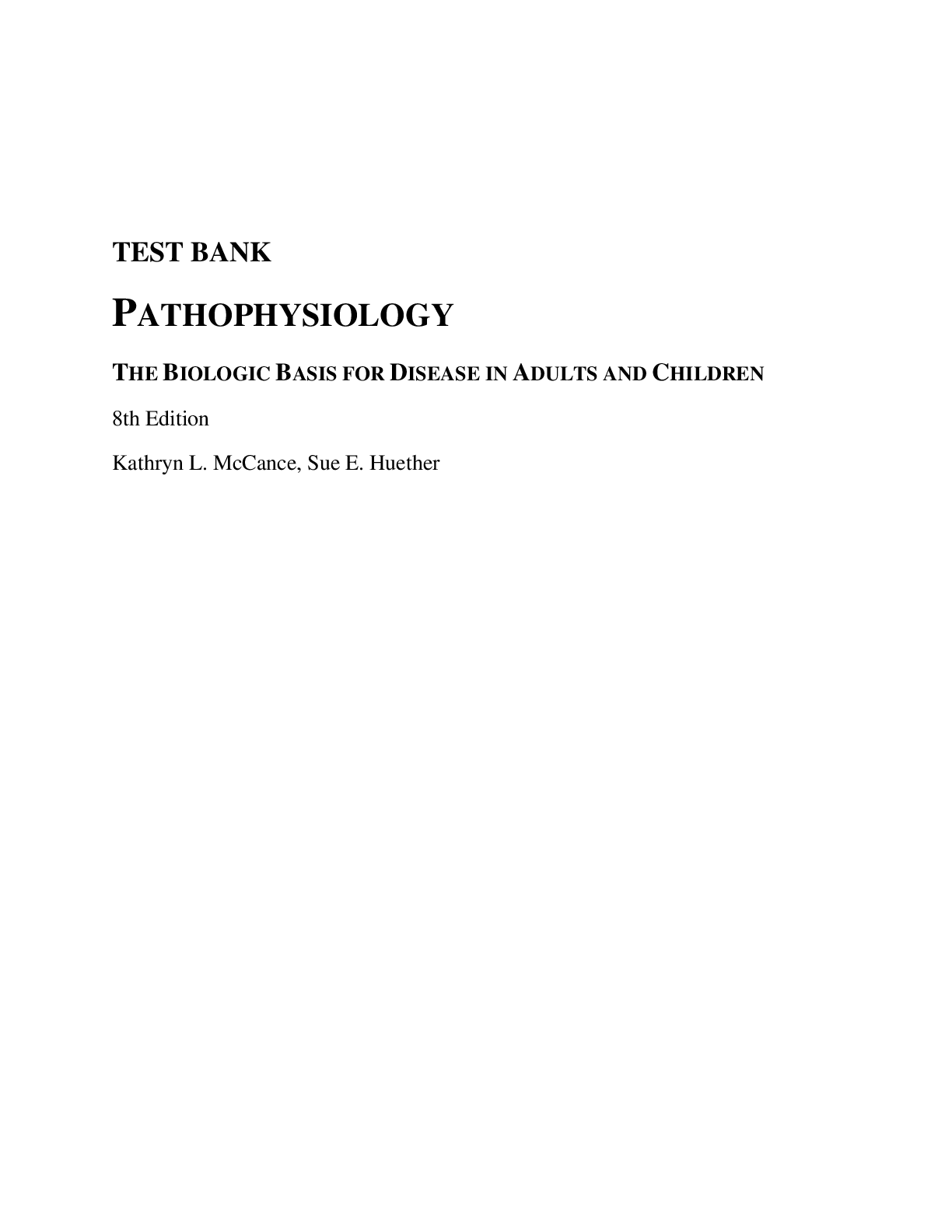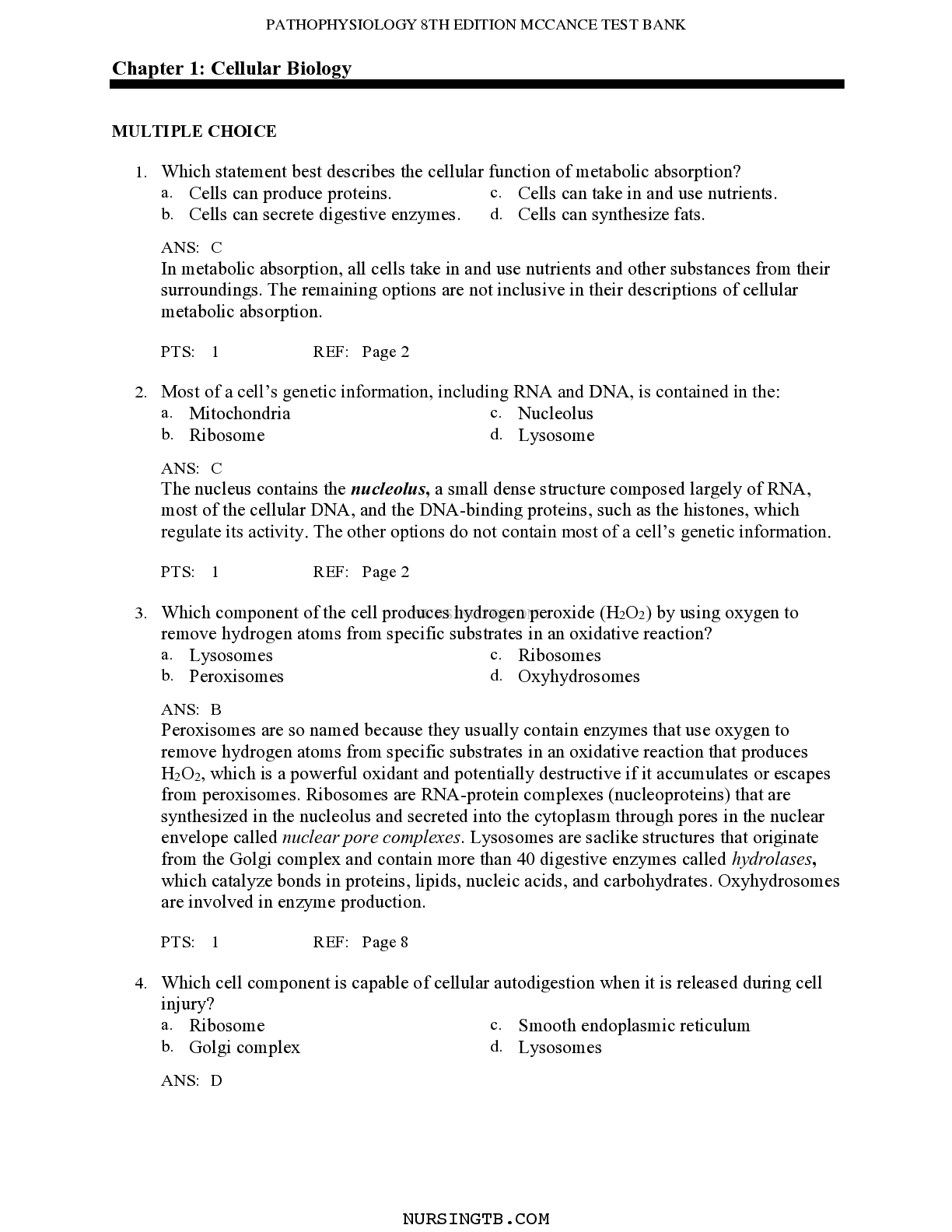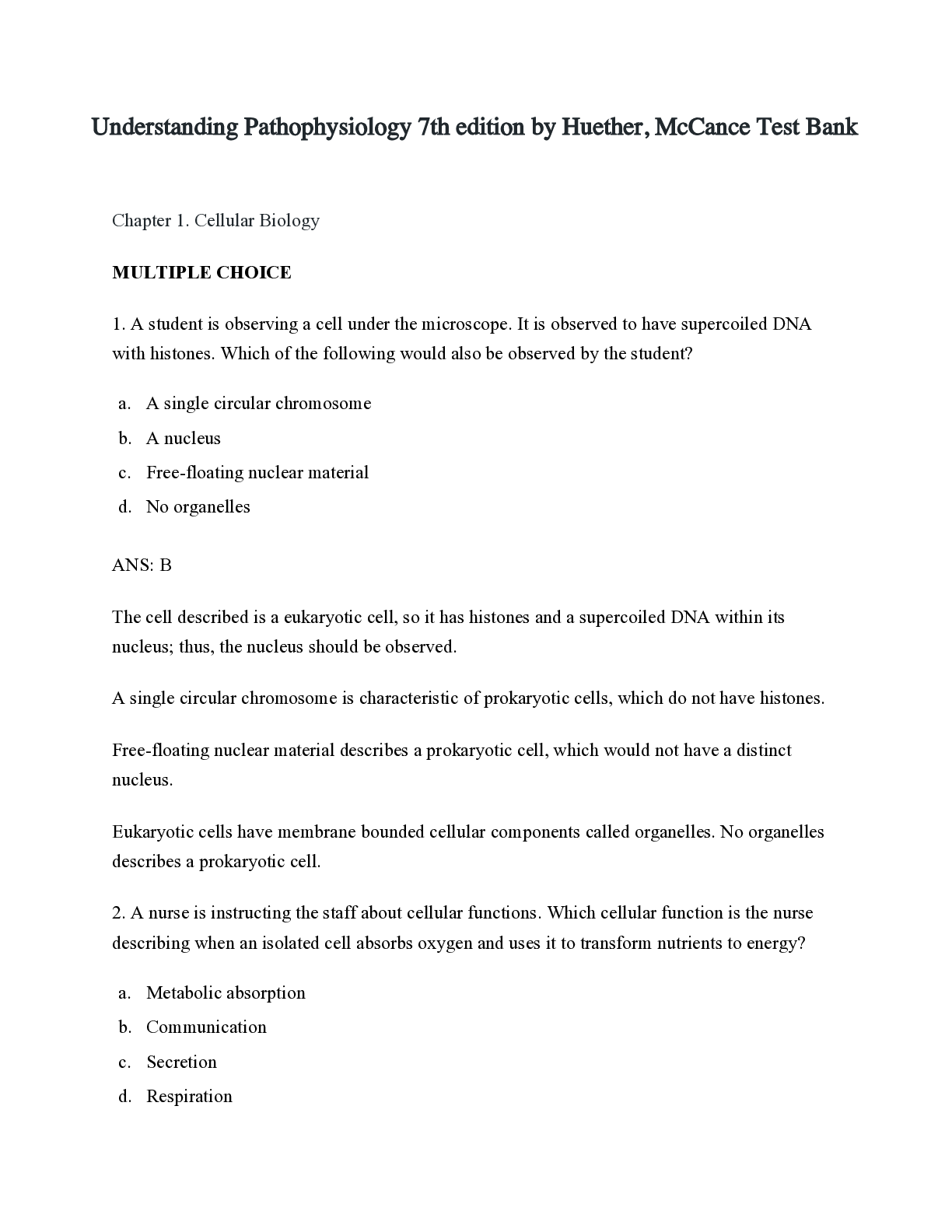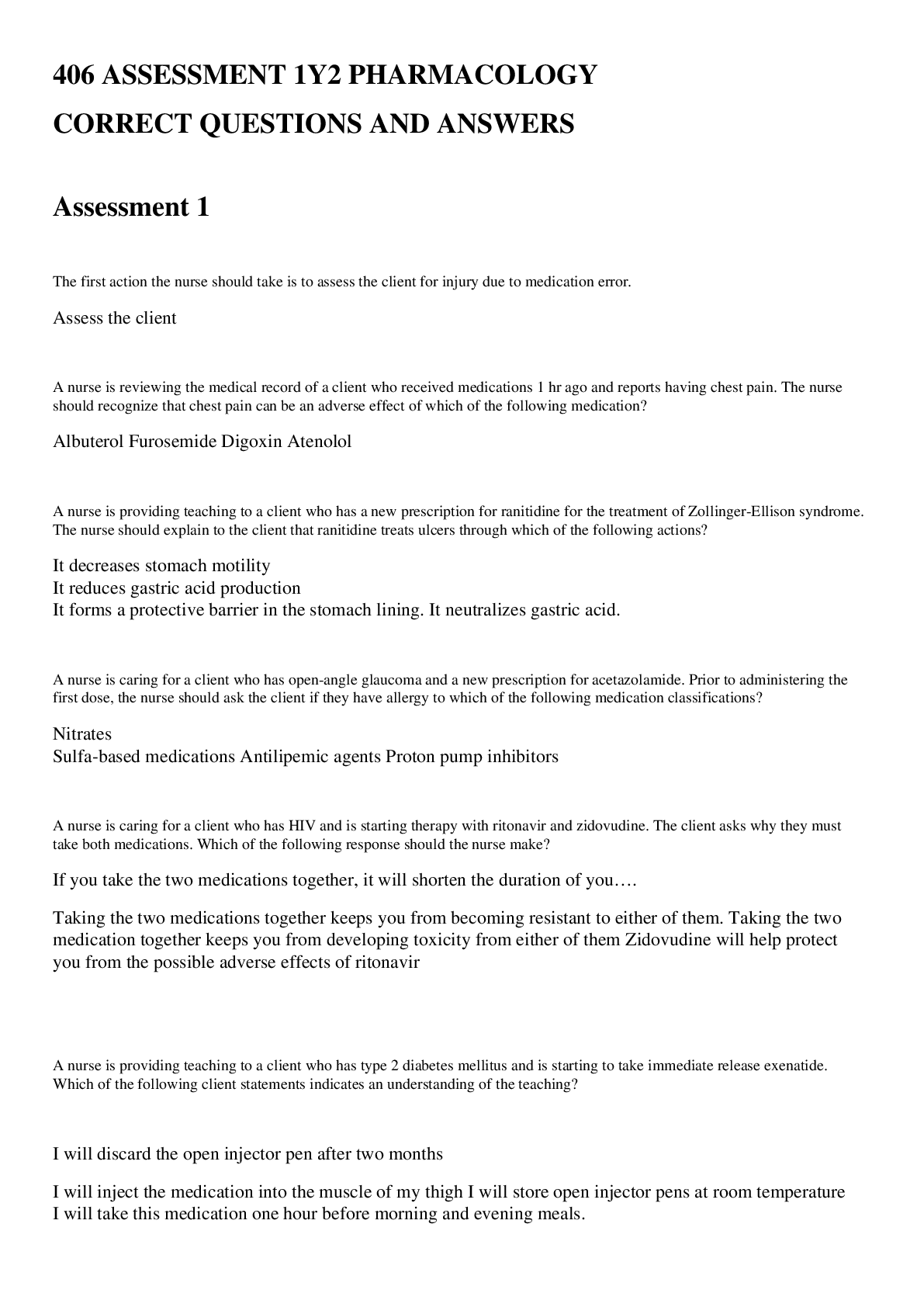*NURSING > QUESTIONS & ANSWERS > NR293 Pharm Workbook Exam 3 Answers (All)
NR293 Pharm Workbook Exam 3 Answers
Document Content and Description Below
Adrenergics (sympathomimetics) Anticholinergics (parasympatholytics) Decongestants Expectorants Antihistamines antiitussive Nonsedating antihistamines (nonsedating) Upper respiratory tract infectio... n (URI): “The inflammatory response elicited by viruses stimulates excessive mucus production. This fluid drips behind the nose, down the pharynx, and into the esophagus and lower respiratory tract, which leads to symptoms typical of a cold: Irritation of the nasal mucosa often triggers the sneeze reflex and also causes the release of several inflammatory and vasoactive substances, which results in the dilation of the small blood vessels in the nasal sinuses and leads to nasal congestion. Treatment of the common symptoms of URI involves the combined use of antihistamines, nasal decongestants, antitussives, and expectorants. OTC cold products should not be given to children younger than 2 years of age. This followed numerous case reports of symptoms such as over-sedation, seizures, tachycardia, and even death in toddlers. There is also evidence that such medications are simply not effective in small children, and parents are advised to consult their pediatrician. Many antihistamines, nasal decongestants, antitussives, and expectorants are available without prescription. Herbal products commonly used for colds are echinacea and goldenseal. There is limited research data regarding the efficacy of herbal products, and some can have significant drug-drug or drug-disease interactions” (Lilley, Collins, & Snyder, 2014, p. 576) Name of drug: Diphenhydramine Loratadine, Cetirizine, Fexofenadine Drug Class & Indication(s) First generation antihistamine/ Second-generation antihistamines (“non-sedating”) Contraindications Acute asthma/COPD exacerbation Acute asthma/COPD exacerbation Common Adverse Effects Major Interactions (ex. CYP450) *Diphenhydramine: increased CNS depression: with: + Alcohol, CNS depressants + MAOI’s ✕ Generally, effect of antihistamines potentiated by ✕ apple, grapefruit, orange juice and St. John’s Wort Loratidine levels increase with: + Ketoconazole + Cimetidine + Erythromycin & Phenytoin FENOFEXADINE-CYP450!! Monitor closely for drug interactions with this med: Fenofexadine levels increase with: + Erythromycin and other CYP450 inhibitors + Phenytoin Nurse Considerations: (Examples: Age, renal/hepatic *Sedating: avoid activities that require alertness (driving, etc) *If treating allergic rhinitis, best to take before allergy symptoms occur precautions, safety with administration, lab monitoring, teaching) *Avoid alcohol *Avoid in the elderly *CAUTION: glaucoma, BPH, liver/renal disease *Freq. mouth care; sugar-free candy or gum 2/23/17 CJR References from the textbook & study guide of: Lilley, L. L., Collins, S. R., Snyder, J. S. (2014). Pharmacology & the Nursing Process, 7th Edition. Mosby Name of drug: Pseudoephedrine Phenylephrine nasal spray Fluticasone nasal spray Drug Class & Indication(s) Sympathomimetics/ adrenergic Corticosteroid topical Contraindications: Avoid in uncontrolled hypertension, CAD, dysrhythmias, hyperthyroidism Avoided with nasal bleeding Common Adverse Effects NASAL SPRAY: Don’t use for > 2 to 3 days, or may develop REBOUND NASAL CONGESTION! NASAL SPRAY: Don’t expect very much “systemic” absorption of this drug, but SOME patients may get SNS adverse effects if too much is used. * THINK STIMULATION OF SYMPATHETIC NERVOUS SYSTEM! (Fight or flight!) Nasal bleeding or local nasal irritation from using any type of nasal medication Major Interactions Nurse Considerations: Discuss the stimulation of the sympathetic nervous system with patient, assess vital signs carefully Avoid caffeine. Nasal rebound is biggest teaching point; also teach correct nasal medication technique teach correct nasal medication technique Takes about 1 week to be fully effective. Name of drug: Dextromethorphan Benzonatate Codeine or Hydrocodone (combination products) Guaifenesin Drug Class & indication(S) Antitussives/ Dry or non-productive cough Expectorant/ Productive cough: helps to thin secretions Contraindications 1 2/23/17 CJR References from the textbook & study guide of: Lilley, L. L., Collins, S. R., Snyder, J. S. (2014). Pharmacology & the Nursing Process, 7th Edition. Mosby Common Adverse Effects Sedation, dizzy, nausea/vomiting/constipation Sedation, dizzy, and nausea Major Interactions Nurse Considerations: (Examples: Age, renal/hepatic precautions, safe administration, lab monitoring, patient teaching) DEXTROMETHORPHAN: Potential for abuse when consumed in large quantities (esp.teenagers) OTC meds are meant for short-term use only OPIOID COUGH SYRUPS: Potential for abuse. Teach safety- no driving, no alcohol, avoid other sedatives; nausea and constipation are more common with opioids.CAUTION: elderly, increased risk of falls or drop in BP *Increase fluid intake, unless fluid restrictions * OTC meds are meant for short-term use only Key Concepts Chapters Student Notes Respiratory Drugs Chapter 37 BOX 37-2 CLASSIFICATIONS OF DRUGS USED TO TREAT ASTHMA Long-Term Control Leukotriene receptor antagonists Mast cell stabilizers Inhaled corticosteroids Anticholinergic agents Long-acting beta2 agonists (LABA) Theophylline Long-acting beta2 agonists in combination with inhaled corticosteroids Quick Relief Intravenous systemic corticosteroids Short-acting inhaled beta2 agonists (rescue agents) Lilley, Linda L., Shelly Collins, Julie Snyder. Pharmacology and the Nursing Process, 7th Edition. Mosby, 2013. Lilley 590) .Name of drug Albuterol Ipratropium / Tiotropium (Long-acting) Drug Class & Indication(s) Beta agonist/ Bronchodilator-quick acting/ Rescue therapy Anticholinergic/ ASTHMA/COPD CONTROLLER Contraindications Common Adverse STIMULATION OF SYMPATHETIC NERVOUS SYSTEM! ANTCHOLINERIC ADVERSE EFFECTS: 2 2/23/17 CJR References from the textbook & study guide of: Lilley, L. L., Collins, S. R., Snyder, J. S. (2014). Pharmacology & the Nursing Process, 7th Edition. Mosby Effects (Fight or flight!) Tachycardia, palpitations hypertension, nervousness, tremor, anxiety, insomnia, Dizziness, drowsiness, orthostasis; Dry mouth or throat & cough; Heart palpitations, dizziness; nausea, constipation, urinary retention; Increased intraocular pressure Major Interactions Nurse Considerations: (Examples: Age, renal/hepatic precautions, safe administration, lab monitoring, teaching) *Discuss the stimulation of the sympathetic nervous system with patient, assess vital signs frequently; monitor pulse oximetry; assess lung sounds & Cardio system *Spacer if child or can’t coordinate *Avoid caffeine. *teach correct technique *teach this is RESCUE inhaler *Caution with glaucoma & BPH *teach correct inhaler technique *teach this is NOT RESCUE inhaler, it is controller *Don’t stop treatment without consulting doctor [Show More]
Last updated: 2 years ago
Preview 1 out of 20 pages

Buy this document to get the full access instantly
Instant Download Access after purchase
Buy NowInstant download
We Accept:

Reviews( 0 )
$7.50
Can't find what you want? Try our AI powered Search
Document information
Connected school, study & course
About the document
Uploaded On
May 11, 2022
Number of pages
20
Written in
Additional information
This document has been written for:
Uploaded
May 11, 2022
Downloads
0
Views
70










.png)



